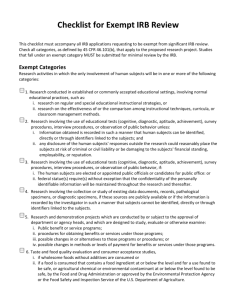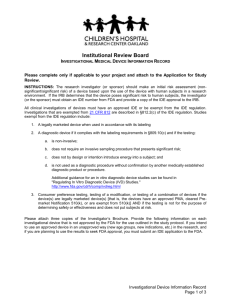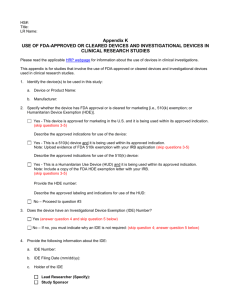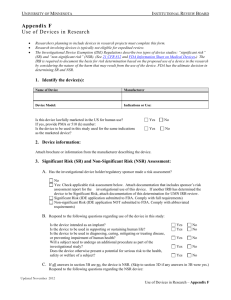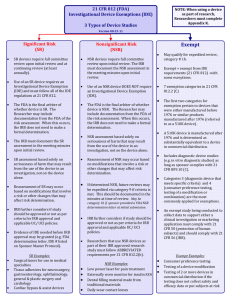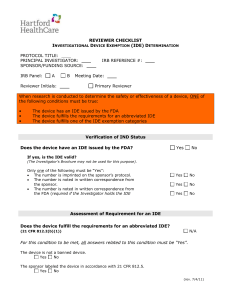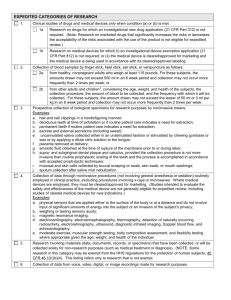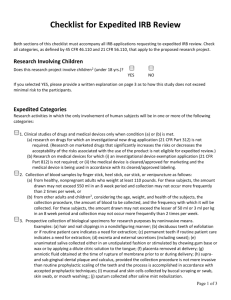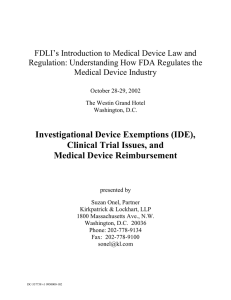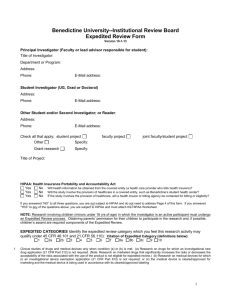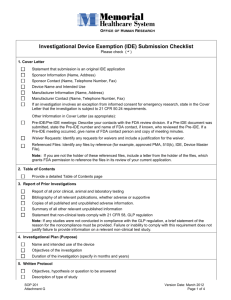Investigator Justification for IDE Exemption
advertisement
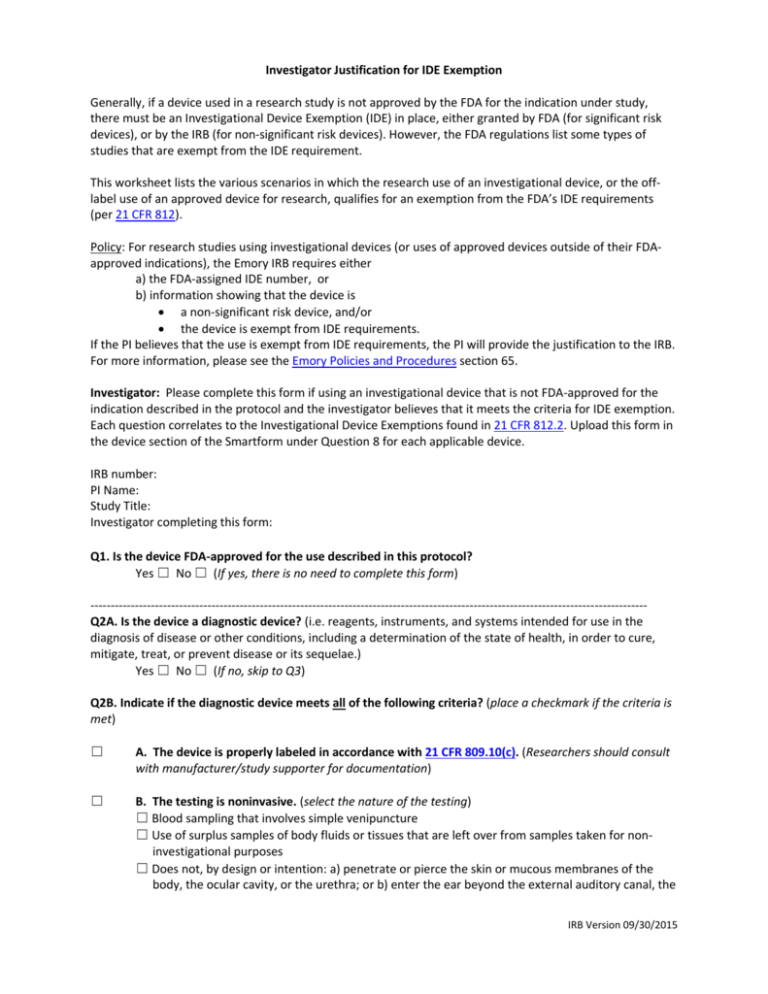
Investigator Justification for IDE Exemption Generally, if a device used in a research study is not approved by the FDA for the indication under study, there must be an Investigational Device Exemption (IDE) in place, either granted by FDA (for significant risk devices), or by the IRB (for non-significant risk devices). However, the FDA regulations list some types of studies that are exempt from the IDE requirement. This worksheet lists the various scenarios in which the research use of an investigational device, or the offlabel use of an approved device for research, qualifies for an exemption from the FDA’s IDE requirements (per 21 CFR 812). Policy: For research studies using investigational devices (or uses of approved devices outside of their FDAapproved indications), the Emory IRB requires either a) the FDA-assigned IDE number, or b) information showing that the device is a non-significant risk device, and/or the device is exempt from IDE requirements. If the PI believes that the use is exempt from IDE requirements, the PI will provide the justification to the IRB. For more information, please see the Emory Policies and Procedures section 65. Investigator: Please complete this form if using an investigational device that is not FDA-approved for the indication described in the protocol and the investigator believes that it meets the criteria for IDE exemption. Each question correlates to the Investigational Device Exemptions found in 21 CFR 812.2. Upload this form in the device section of the Smartform under Question 8 for each applicable device. IRB number: PI Name: Study Title: Investigator completing this form: Q1. Is the device FDA-approved for the use described in this protocol? Yes ☐ No ☐ (If yes, there is no need to complete this form) -----------------------------------------------------------------------------------------------------------------------------------------Q2A. Is the device a diagnostic device? (i.e. reagents, instruments, and systems intended for use in the diagnosis of disease or other conditions, including a determination of the state of health, in order to cure, mitigate, treat, or prevent disease or its sequelae.) Yes ☐ No ☐ (If no, skip to Q3) Q2B. Indicate if the diagnostic device meets all of the following criteria? (place a checkmark if the criteria is met) ☐ A. The device is properly labeled in accordance with 21 CFR 809.10(c). (Researchers should consult with manufacturer/study supporter for documentation) ☐ B. The testing is noninvasive. (select the nature of the testing) ☐ Blood sampling that involves simple venipuncture ☐ Use of surplus samples of body fluids or tissues that are left over from samples taken for noninvestigational purposes ☐ Does not, by design or intention: a) penetrate or pierce the skin or mucous membranes of the body, the ocular cavity, or the urethra; or b) enter the ear beyond the external auditory canal, the IRB Version 09/30/2015 nose beyond the nares, the mouth beyond the pharynx, the anal canal beyond the rectum, or the vagina beyond the cervical os ☐ C. The testing does not require an invasive sampling procedure that presents significant risk. (i.e. require biopsy of a major organ, use of general anesthesia, or placement of a blood access line into an artery or large vein) ☐ D. The testing does not by design or intention introduce energy into a subject. (MRI and ultrasound are examples of IVDs which introduce energy, while home test kits are IVDs which do not by design or intention introduce energy.) ☐ E. The testing is not used as a diagnostic procedure without confirmation of the diagnosis by another, medically established diagnostic product or procedure. Specify medically established diagnostic product or procedure to be used: OR ☐ The device does not meet all the above criteria for an exempt IVD because: -----------------------------------------------------------------------------------------------------------------------------------------Q3A. Was the device, other than a transitional device, in commercial distribution prior to May 28, 1976? Yes ☐ No ☐ Q3B: Is the device now used or investigated in accordance with the indications and labeling in effect at that time? Yes ☐ No ☐ -----------------------------------------------------------------------------------------------------------------------------------------Q4. Has the device, other than a transitional device, been found to be substantially equivalent to a device in commercial distribution prior to May 28, 1976 and is it being used or investigated according to the indications in the labeling reviewed by FDA in determining substantial equivalence? Yes ☐ No ☐ -----------------------------------------------------------------------------------------------------------------------------------------Q5. Is the device undergoing consumer preference testing, testing of a modification, or testing of a combination of two or more devices in commercial distribution, and the testing is not for the purpose of determining safety or effectiveness and does not put subjects at risk? Yes ☐ No ☐ -----------------------------------------------------------------------------------------------------------------------------------------Q6A. Is the device a custom device as defined in 21 CFR 812.3(b)? Yes ☐ No ☐ Q6B. Is the custom device being used to determine safety or effectiveness for commercial distribution? Yes ☐ No ☐ Thank you! The IRB member(s) will include this information in their review of the research protocol. IRB Version 09/30/2015
